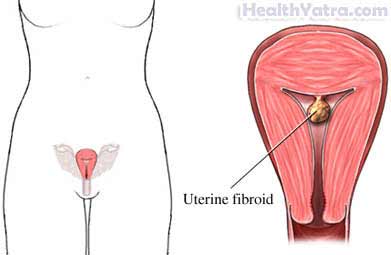Uterine Fibroids Treatment Cost in India
Fibroids are benign (noncancerous) growths in the wall of the uterus. The uterus is the organ where a fetus grows during pregnancy.
Fibroids are common. They may be very small or they could grow to eight or more inches in diameter. Most fibroids remain inside the uterus. In rare cases, they may stick out and affect nearby organs. It is common for there to be more than one fibroid.

কারণসমূহ
The cause of fibroids is unknown.
Fibroid growth is stimulated by female reproductive hormones. As a result:
- Fibroids grow larger during pregnancy then shrink after childbirth.
- Fibroids become less of a problem after menopause. However, symptoms may return with hormone replacement therapy (HRT)
Genetics may make some women more prone to fibroids. Substances that control blood vessel growth may also affect fibroid growth.
ঝুঁকির কারণ
Certain factors affect your risk of fibroids, for example:
- Risk increase with age until menopause
- African American women have increased risk of fibroids
- পারিবারিক ইতিহাস
Obesity and high blood pressure may also be linked to fibroids.
লক্ষণ
Symptoms range from none at all to mild or severe. This depends on the size and location of the growths.
উপসর্গ অন্তর্ভুক্ত হতে পারে:
- পেলভিক ব্যথা
- Feeling of pelvic pressure
- Heavy menstrual bleeding
- Clots in menstrual flow
- Long periods
- Bleeding between periods
- Increased cramping during periods
- Pain during sex
- Frequent need to urinate
- কোষ্ঠকাঠিন্য
- ফোলা
- Enlarged uterus (giving the appearance of pregnancy)
- Low back or leg pain
- Infertility by blocking the fallopian tubes
- গর্ভপাত
Iron-deficiency anemia may develop if bleeding is heavy. This is low levels of red blood cells. It will affect the amount of oxygen your blood can carry.
রোগ নির্ণয়
Doctors find most fibroids during routine pelvic exams.
To confirm the diagnosis, your doctor may want to get a detailed picture of the fibroid. This may be taken with one or more of the following tests:
- পেটের আল্ট্রাসাউন্ড
- Transvaginal ultrasound
- গণনা করা টমোগ্রাফি (CT) scan or magnetic resonance imaging (MRI)
- হিস্টেরোস্কোপি
চিকিৎসা
Most women with fibroids have no symptoms and do not need treatment. Your doctor may recommend “watchful waiting”. During this period your doctor will monitor any changes on a regular basis. Treatment may be done later if needed.
চিকিত্সা অন্তর্ভুক্ত:
Pain Medication
Your doctor may recommend:
- Over-the-counter pain relievers to ease mild symptoms
- Nonsteroidal anti-inflammatory drugs (NSAIDs) to reduce inflammation and relieve cramping
- Prescription pain medicine—If pain cannot be managed with medications above
হরমোনাল থেরাপি
Hormone medicines may be an option if you are not trying to become pregnant. These drugs can shrink fibroids and lessen pain. However, fibroids can return once you stop taking the drugs. These drugs may be used to make fibroids smaller just before surgery.
পদ্ধতি
Surgery may be considered if:
- The uterus becomes extremely large
- The fibroids are interfering with fertility
- Symptoms are severe
অস্ত্রোপচার পদ্ধতি অন্তর্ভুক্ত:
- Myomectomy—An incision is made in the abdomen. The fibroids are removed from the uterus.
- Hysterectomy—The entire uterus is removed. You will be unable to have children if you have this surgery.
Other options include:
- Uterine fibroid ablation—This is a minimally invasive procedure. It blocks blood flow to the fibroids. This will make the fibroids shrink.
- Focused ultrasound therapy—Energy is centered on the fibroid to destroy it. This procedure may not be ideal for patients who are very overweight, have very large fibroids, or have extensive scars from prior abdominal surgeries.
If you are diagnosed with uterine fibroids, follow your doctor’s instructions.
প্রতিরোধ
There are no guidelines for preventing fibroids.
